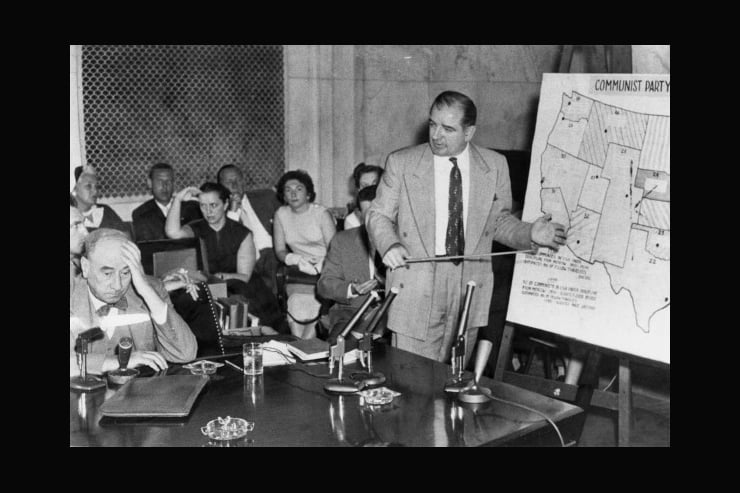Tudor Dixon—the Republican gubernatorial challenger in Michigan—compared incumbent Governor Gretchen Whitmer to an armed kidnapper who “will tie your hands, put a gun to your head and ask if you’re ready to talk.” After a brief pause, Dixon delivered the punchline, “For someone so worried about being kidnapped, Gretchen Whitmer sure is good at taking business hostage and holding it for ransom.”
Dixon’s kidding about kidnapping, referencing the 2020 plot to kidnap Whitmer, got traction in the media because it fed into an existing narrative: that Dixon is a “conspiracy theorist.”
The “conspiracy theorist” moniker has long been the left’s preferred label for anyone who notices what they’re up to. Joe McCarthy was a conspiracy theorist because he noticed that the State Department was hiring Communists.
This tactic can be effective when only a few people notice what the left is doing, but it is hard to keep that knowlege limited in the digital age. If one man made the claim that Michigan Attorney General Dana Nessel was working to put drag queens in schools, he could be easily written-off as a conspiracy theorist. But that tactic doesn’t work when video of Nessel admitting as much is on YouTube.
In 2008, when social media and YouTube were beginning to take off, Cass Sunstein—a Harvard don and soon-to-be Obama administration appointee—realized that a more proactive strategy was needed to combat the right’s increasing proficiency at noticing leftist plots. In an article titled “Conspiracy Theories,” published by the University of Chicago Law School, Sunstein explained that “the best response” to conspiracy theories “consists in cognitive infiltration of extremist groups.”
According to Sunstein, the big problem with right-wing conspiracists is that they live in communities with “a shared sense of identity and are connected by bonds of solidarity.” This in-group preference renders direct rebuttals from government outsiders futile. Therefore, infiltration is the government’s best strategy for combatting them.
Sunstein’s piece reads like an FBI undercover agent’s guide on how to get conservatives to agree to reckless and dangerous ideas that they’d otherwise never consider. Sunstein sandwiches manipulative psychological techniques between flowery reminders about the goal of introducing the conspiracists to “diverse viewpoints.”
One year after the article’s publication, Sunstein took leadership of the White House Office of Information and Regulatory Affairs. He left government in 2012, but there is reason to suspect his ideas lingered in Washington.
In October of 2020, the FBI revealed the plot to kidnap Governor Whitmer. The Bureau had attempted some “cognitive infiltration” of a conspiracist group in Michigan called the Wolverine Watchmen. The group’s ringleader, according to the Feds, was 38-year-old Adam Fox—known to friends and family as “Captain Autism.” Whether Fox had enough cognizance to be “cognitively infiltrated” is debatable.
In the FBI’s undercover recordings, Fox vacillates between supporting and opposing the kidnapping. As one Wolverine Watchman texted another in July 2020, “Captain Autism can’t make up his mind.”
Fox’s actual plotting of the kidnapping drifts from strategy to fantasy. At times he talks as though he and his buddies are filming a Mission Impossible sequel, with speedboats, explosives, and Blackhawk helicopters. Perhaps the swell deal that the Watchmen got on explosives—from an undercover FBI agent—prompted Fox to think he could get just about anything from these strange men who recently entered his life and indulged his fantasies.
The Jan. 6 Capitol Hill riot had a much more decisive leader: Ray Epps. Epps appears repeatedly on film that day encouraging others to breach the barrier around the Capitol and enter the building.
The FBI put Epps on its “U.S. Capitol Violence Most Wanted” list for a few hours before mysteriously removing him and scrubbing his name entirely from their website. When Senator Ted Cruz asked Jill Sanborn, executive assistant director of the National Security Branch of the FBI, whether Ray Epps was a Fed, she replied, “I cannot answer that.” She gave the same answer to all questions regarding the FBI’s involvement with Jan. 6. More than 18 months later, Republicans are still asking about Epps, and Democrats are still calling them conspiracy theorists when they do.
Anybody who questions the left’s narrative of events is branded a conspiracy theorist. That tactic is not new, but the increased visibility of the government’s hand in manufacturing those events is obvious.
The left sees those outside government conspiring to harm those inside; the right sees those inside government conspiring to hurt those outside. Experience—and Professor Sunstein’s writings—indicate the latter is more likely.
—John Howting

Leave a Reply